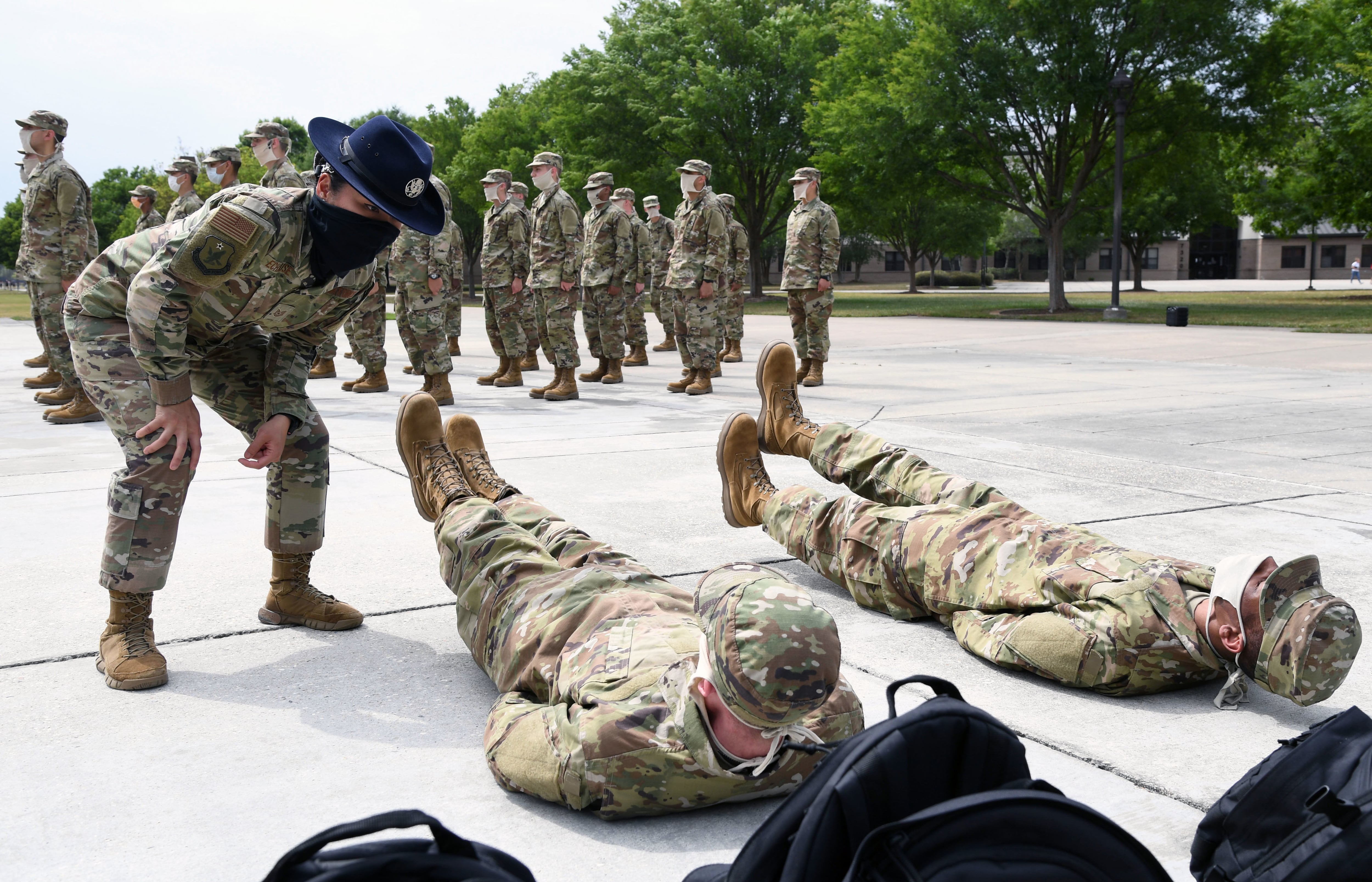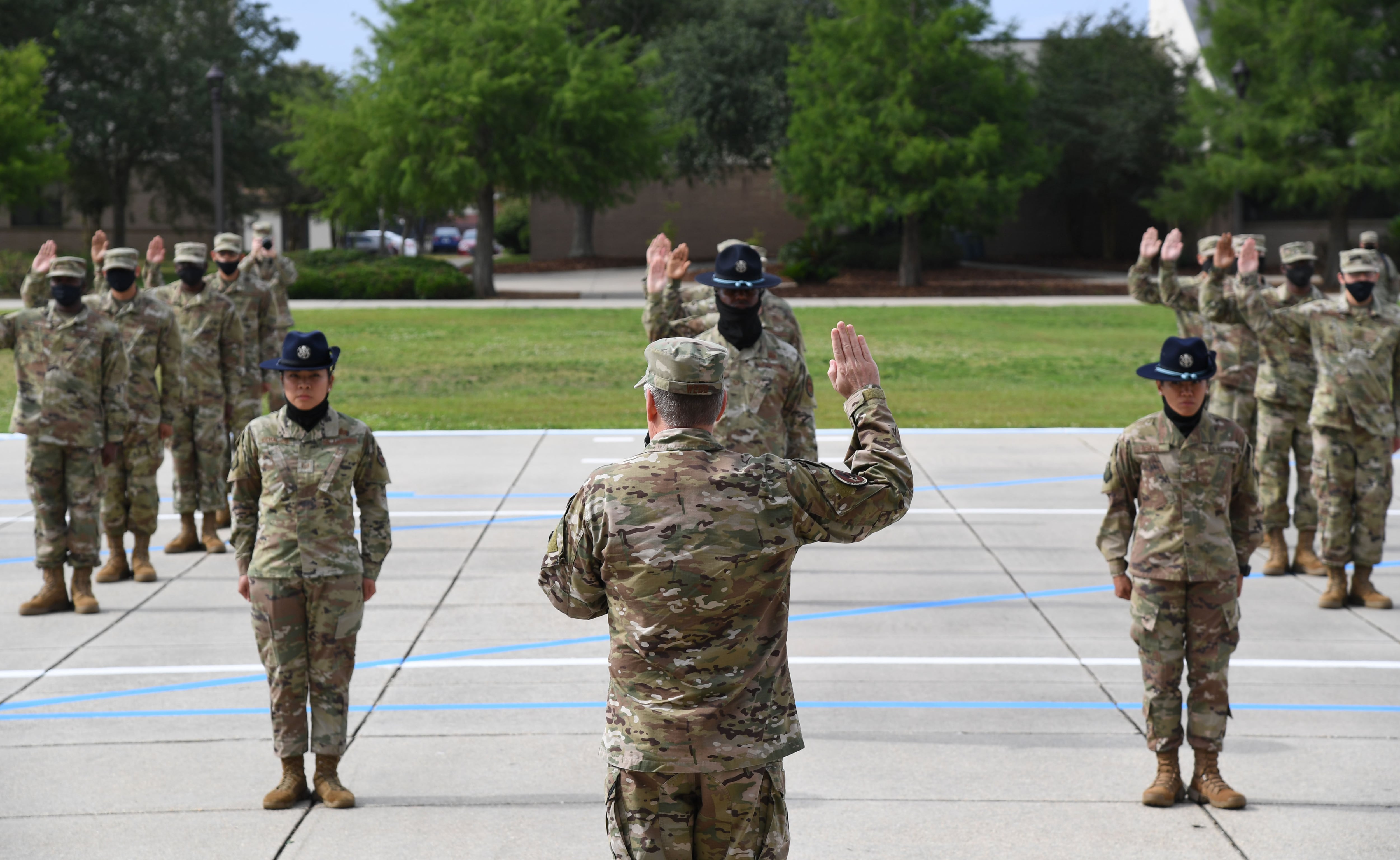The Air Force will keep holding basic military training at a secondary site at Keesler Air Force Base in Mississippi to help it keep creating new airmen during the coronavirus crisis.
Air Education and Training Command announced Tuesday that it will start bringing in 60 new recruits each week to Keesler for basic training on June 2, and could continue through the end of September.
Since 1968, the Air Force has conducted BMT — its boot camp — at Joint Base San Antonio-Lackland. But in April, as the coronavirus pandemic spread and officials growing increasingly concerned that it needed to spread out basic training to alternate locations, the Air Force launched a proof-of-concept test at Keesler to see if it could work.
That initial class of nearly 60 new airmen, from the 37th Training Wing, Detachment 5, graduated on May 15. And in a conference call with reporters, 2nd Air Force commander Maj. Gen. Andrea Tullos said the experiment was a success.
Tullos told reporters that basic trainees will ship directly to Keesler, and after they graduate, will stay in the Keesler area for their follow-on technical training. This will allow newly-graduated airmen to avoid having to pass through transit stations such as airports or bus terminals on their way to technical training, reducing the likelihood of them catching or spreading coronavirus, she said.
Keesler conducts technical training for about 160 career fields, including personnel, cyber, financial management, electronic communication systems, air traffic control, weather, and airfield management.
Tullos said Keesler will train active, Guard and Reserve airmen, and will have reached full operating capability when it has 360 airmen in the pipeline, which will likely happen in mid- to late July.
Conducting BMT at Keesler doesn’t just spread out training in case of a COVID-19 outbreak at Lackland, Tullos said. It also frees up some space at Lackland to deep-clean and repair some of its older infrastructure.
And it will help Lackland be ready if the coronavirus comes back, perhaps in the colder winter months and flu season.
“We are going to be under COVID conditions for perhaps a lot of the year,” Tullos said. “We have to be prepared for waves of this — we go through a period where we’re allowed to relax a little, but we might have to go back into a more restricted lockdown. To the extent that we can get additional production through the pipeline before the winter months come in ... we’re in a much better position.”
But while training at Keesler is going well for now, Tullos said, it still requires additional logistical, medical and administrative support. As a result, she doesn’t think it would be a good idea to keep BMT going at a second location in the long term, even while the coronavirus is continuing.
The Air Force wants to graduate 12,800 total force airmen, including 9,400 active duty, from BMT between now and the end of the fiscal year, Tullos said. To meet that goal, Lackland and Keesler combined will have to bring about 700 new airmen into the pipeline every week.

BMT graduation ceremonies at Keesler will remain closed to the public, as they are at Lackland, but will be livestreamed, Tullos said.
Tullos said one of the biggest questions before the proof-of-concept test in April and May was how the COVID-19 pandemic might have affected the health of incoming recruits — such as their fitness after extended lockdowns, and whether they would be stressed or fatigued.
To adjust, Keesler instructors tried to acclimate new basics slowly. They moved some of the more administrative lessons, which typically were conducted later in the course, to the beginning so basics could ease into training.
RELATED

The training regimen at Keesler is also more compressed, taking place in six weeks instead of the 7 ½ week-course at Lackland. Airman at Keesler train 10 hours a day, six days a week, instead of 8 hours a day.
But Tullos said Keesler is also making sure it carefully and deliberately trains its airmen, so they don’t suffer leg, foot or ankle injuries during the shorter time frame. That included reorganizing the order of some activities.
And while instructors and trainees are following guidelines to discourage the spread of coronavirus, including wearing masks, they’re still trying to train in the sweltering heat of Biloxi, Mississippi. Tullos said instructors can give trainees permission to take their masks off, to avoid breathing problems. Trainees can also be moved into the shade or indoors to avoid issues such as heat stroke.
“During the summer months, particularly in the Deep South, we have to keep heat threats at the forefront,” Tullos said.
New recruits will be tested for coronavirus immediately after arriving at Keesler, said Lt. Col. Rob Nyquist, AETC’s public health officer, and then will be isolated for 14 days. After that two-week quarantine, they will be tested again.
The smaller class size and closer quarters, as compared to Lackland, allowed trainees at Keesler to have a more intense, hands-on experience with instructors, Tullos said. But there were also challenges at Keesler, particularly getting the sizing and tailoring of blue uniforms right.
And getting the milestone of the haircut for the incoming trainee right also took some doing, Tullos said. Barbershops can be social places where barbers chit-chat with their customers — but not for new recruits.
“That’s a significant emotional event for a new recruit, to show up and get their first military haircut,” Tullos said. “At basic training, there is no social aspect — you get in the chair, they cut your hair, you move on. So there was some training that had to go on with the barbers, because quite naturally, they wanted to have some extended conversations with the recruits. But the military training instructors let them know they weren’t really interested in socializing at that point in time.”
Stephen Losey is the air warfare reporter for Defense News. He previously covered leadership and personnel issues at Air Force Times, and the Pentagon, special operations and air warfare at Military.com. He has traveled to the Middle East to cover U.S. Air Force operations.




